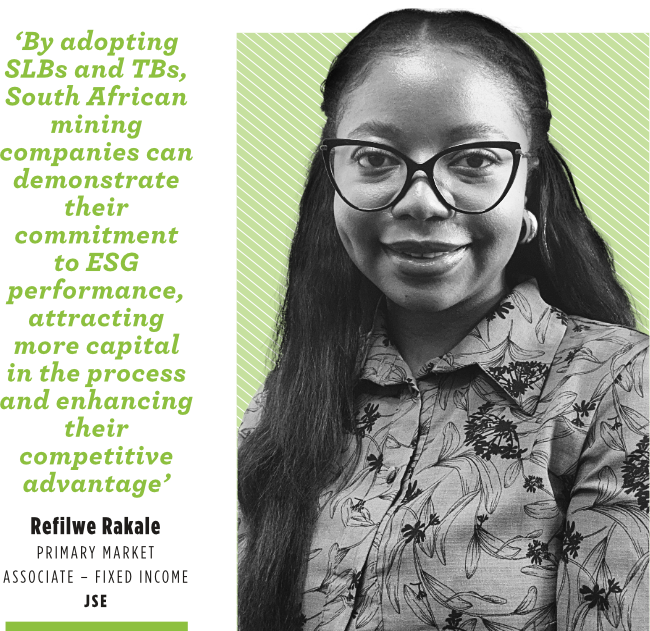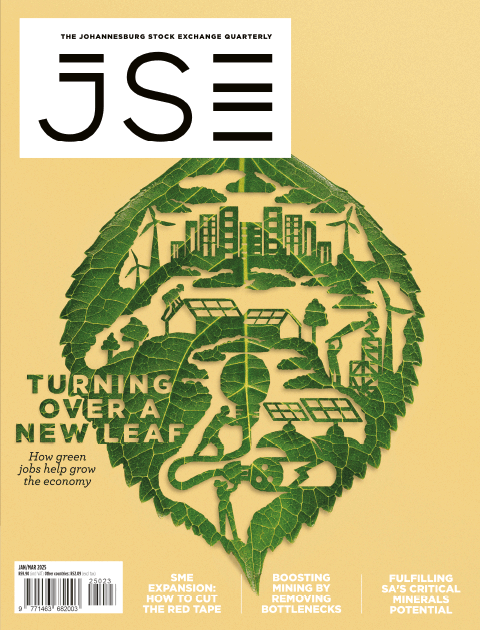The ability to raise capital is of utmost importance to any company. However, as the world grapples with climate change, sustainable financing has become a crucial element of doing business. Sustainability-linked bonds (SLBs) and transition bonds (TBs) are innovative financial instruments designed to promote sustainable practices.
‘These bonds play a significant role in directing capital towards projects that contribute to environmental sustainability,’ says Refilwe Rakale, Primary Market Associate – Fixed Income at the JSE. ‘These bonds can provide companies with broader access to capital markets and potentially lower borrowing costs due to the growing demand for sustainable investment options.’
She says SLBs are bonds where the financial terms, such as interest rates, can vary depending on whether the issuer meets pre-defined sustainability objectives.
‘These objectives are typically linked to key performance indicators [KPIs] related to environmental, social and governance criteria. Common KPIs include reductions in greenhouse gas emissions, improvements in energy efficiency, land rehabilitation and advancements in social impact metrics.
‘Unlike green bonds, which are earmarked for specific green projects, SLBs provide issuers with the flexibility to use the proceeds for general corporate purposes while committing to broader sustainability goals.’
TBs, on the other hand, are designed to support companies in high-emission sectors – such as mining, oil and gas, and heavy manufacturing – in their efforts to transition towards more sustainable practices.
‘Transition bonds are tailored to industries that are critical to the economy but face significant environmental challenges. These bonds fund activities that help these sectors reduce their carbon footprint and adopt cleaner technologies. Unlike SLBs, which are tied to specific sustainability targets, transition bonds support a wide range of activities that contribute to a low-carbon economy, including energy efficiency improvements, pollution control measures and the adoption of renewable energy sources.’
Rakale says that while the mining sector is a cornerstone of SA’s economy, contributing around 8% to 10% of GDP, it also is a major contributor to environmental degradation. For example, mining activities lead to significant land disturbance, resulting in habitat destruction and soil erosion. This degradation affects biodiversity and the ability of the land to support agriculture and other uses.
Mining operations often also result in the contamination of water sources due to the release of harmful chemicals and heavy metals. This pollution poses serious risks to both human health and aquatic ecosystems in mining communities.
Moreover, the mining sector is a significant source of greenhouse gas emissions, contributing to climate change. Consequently, reducing these emissions is critical for meeting global climate targets.
The industry also faces several social challenges. Mining activities can lead to the displacement of communities, loss of livelihoods, and health impacts due to pollution and unsafe working conditions. Addressing these social issues is essential for sustainable development. The mining sector in SA has a history of labour disputes, safety concerns and poor working conditions, so improving labour practices is crucial for the sector’s sustainability.
Hence by issuing these sorts of bonds, mining companies raise capital earmarked for projects such as reducing carbon emissions, improving waste and water management, and social upliftment, among others.
‘These bonds can finance the transition to renewable energy sources for mining operations, helping to reduce emissions and promote sustainable energy use,’ she says. ‘These bonds enable mining firms to transition toward cleaner technologies, rehabilitate environmental damage, and support community initiatives.
‘This not only ensures regulatory compliance but also strengthens stakeholder trust and long-term profitability. They also attract investors prioritising ethical investment opportunities, broadening the funding base.
‘By adopting SLBs and TBs, South African mining companies can demonstrate their commitment to ESG performance, attracting more capital in the process and enhancing their competitive advantage. This sort of financing can not only help develop new technologies and practices that reduce environmental impact but also position mining companies as leaders in sustainability.’









